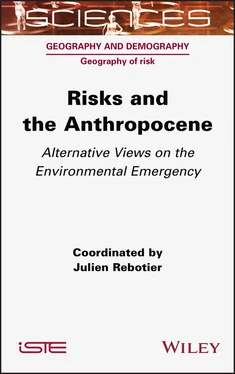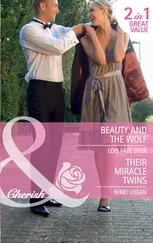Passeron, J.-C. (1995). L’espace mental de l’enquête (I). Enquête , 1, 13–42.
Peet, R. and Watts, M. (1996). Liberation Ecologies. Environment, Development and Social Movements . Routledge, London.
Pelletier, P. (1993). L’imposture écologiste . Reclus, Montpellier.
Pelling, M. (2010). Adaptation to Climate Change: From Resilience to Transformation . Routledge, London.
Pigeon, P. and Rebotier, J. (2016). Disaster Prevention Policies. A Challenging and Critical Outlook . ISTE Press, London, and Elsevier, Oxford.
Rebotier, J. (2020). Adaptation. In Dictionnaire critique de l’anthropocène , Cynorhodon (ed.). CNRS Édition, Paris.
Rebotier, J., Pigeon, P., Metzger, P. (2019). Returning social context to seismic risk knowledge & management. Lessons learned from an interdisciplinary research in the city of Esmeraldas, Ecuador. Cybergeo: European Journal of Geography [Online]. Available at: https://journals.openedition.org/cybergeo/31787[Accessed 11 May 2020].
Ribot, J. (2014). Cause and response: Vulnerability and climate in the Anthropocene. Journal of Peasant Studies , 41(5), 667–705.
Ribot, J. (2019). Social causality of our common climate crisis: Toward a sociodicy for the Anthropocene. In The Commons in a Glocal World: Global Connections and Local Responses , Haller, T., Breu, T., De Moor, T., Rohr, C., Znoj, H. (eds). Routledge, London.
Robbins, P. (2004). Political Ecology: A Critical Introduction . Blackwell Publishing, Hoboken, NJ.
Robic, M.-C. (ed.) (1992). Du milieu à l’environnement : pratiques et représentations du rapport homme-nature depuis la Renaissance . Economica, Paris.
Robic, M.-C. (ed.) (2006). Couvrir le monde. Un grand XXe siècle de géographie française . ADFP, Paris.
Rodríguez, H., Quarantelli, E.L., Dynes, R.R. (2007). Handbook of Disaster Research . Springer, New York.
Rossi, G. (2001). L’ingérence écologique . CNRS Éditions, Paris. Servigne, P. and Stevens, R. (2015). Comment tout peut s’effondrer . Le Seuil, Paris.
Shaw, R. (2013). Disaster risk reduction and community approaches. In Community Practices for Disaster Risk Reduction in Japan , Shaw, R. (ed.). Springer, Tokyo.
Smith, N. (2010). Uneven Development: Nature, Capital, and the Production of Space , 3rd edition. University of Georgia Press, Athens, London.
Steffen, W., Crutzen, P.J., McNeill, J.R. (2007). The Anthropocene: Are humans now overwhelming the great forces of nature? Ambio , 36(8), 614–621.
Steffen, W., Broadgate, W., Deutsch, L., Gaffney, O., Ludwig, C. (2015). The trajectory of the Anthropocene: The Great Acceleration. The Anthropocene Review , 2(1), 81–98.
Theys, J. and Fabiani, J.-L. (eds) (1987). La société vulnérable. Évaluer et maîtriser les risques . Presses de l’École normale supérieure, Paris.
Tissier, J.-L. (1992). La géographie dans le prisme de l’environnement (1970–1990). In Du milieu à l’environnement : pratiques et représentations du rapport homme-nature depuis la Renaissance , Robic, M.-C. (ed.). Economica, Paris.
Tsing, A. (2017). Le champignon de la fin du monde . La Découverte, Paris.
White, G.F., Kates, R.W., Burton, I. (2001). Knowing better and losing even more: The use of knowledge in hazards management. Global Environmental Change Part B: Environmental Hazards , 3(3–4), 81–92.
Wisner, B. (2016). Vulnerability as model, concept, metric and tool. Oxford Research Encyclopedia [Online]. Available at: https://oxfordre.com/naturalhazardscience/view/10.1093/acrefore/9780199389407.001.0001/acrefore-9780199389407-e-25[Accessed 9 May 2020].
Wisner, B. (2019). Disaster studies at 50: Time to wear bifocals? In Disaster Research and the Second Environmental Crisis. Assessing the Challenges Ahead , Kendra, J., Knowles, S.G., Wachtendorf, T. (eds). Springer, Basel.
Wisner, B., Gaillard, J.-C., Kelman, I. (2012). The Routledge Handbook of Disaster Risk Reduction . Routledge, New York.
Yusoff, K. (2018). A Billion Black Anthropocene . University of Minnesota Press, Minneapolis, MN [Online]. Available at: https://manifold.umn.edu/projects/a-billionblack-anthropocenes-or-none[Accessed 17 May 2020].
1 1 This introduction has benefited from the proofreadings and comments of Florent Champy, Pascale Metzger, Catherine Meur-Ferec, Alain Musset, Patrick Pigeon and Sébastien Roux. They are warmly thanked. Thanks also to Denise Pumain and Samuel Rufat for their valuable comments on the book as a whole.
2 2 In the English language, however, it is usual to use a capital “A,” which does not prevent some authors from referring to the “Anthropocene” as an ontological moment (Clark and Yusoff 2017, p. 8), a broader conjuncture of ways of thinking, living, and doing the world, in the same way that we understand the Anthropocene moment in this book.
3 3 Not capitalized in the French version of the book.
4 4 In the absence of a “golden spike”, especially in the most remote geological ages, the boundary can be established by scientific consensus on the basis of less definitive stratigraphic evidence.
5 5As an assemblage of physical and human features involving different spatial scales.
PART 1
Toward Unprecedented Risks?
Конец ознакомительного фрагмента.
Текст предоставлен ООО «ЛитРес».
Прочитайте эту книгу целиком, купив полную легальную версию на ЛитРес.
Безопасно оплатить книгу можно банковской картой Visa, MasterCard, Maestro, со счета мобильного телефона, с платежного терминала, в салоне МТС или Связной, через PayPal, WebMoney, Яндекс.Деньги, QIWI Кошелек, бонусными картами или другим удобным Вам способом.












